
I use the following computers on a regular basis:

This was the machine that I used at the last two places I worked at before my current job. That was pretty easy to do, since I used to work at SGI, then I took a job maintaining SGIs and other computers. I also have an O2 has my home computer, which has been upgraded with the O2+'s RM5271 300MHz CPU, and that is what I am typing this in on. I've set up several O2s, and they're sweet littje boxes. O2's will even restart themselves at a time you select--so instead of having just your coffee pot turn on in the morning and be ready for you, your computer can be ready as well! Of course, I rarely drink coffee, and don't have a coffee maker at home, so none of this matters to me. The low-end O2s used the R5000 CPU, and they also can use the R10000 or R12000. The ability to hold 1GB of RAM doesn't exactally hurt either! The O2+ is just an O2 with a RM5271 or R14000 CPU in it, and a different colored case. And don't forget to secure your IRIX system against break-ins.
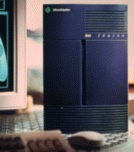
This was a R3300 33MHz slow slow slow machine. I used to use it to log into machines that are crashing or otherwise engaged, but sometimes I logged into it just to experience the incredible slowness of it all. It was very interesting to log into because the interface is much the same as a more modern O2 or Octane2, but there are subtle differences in it all, because the R3300 can only handle up to IRIX 5.3. I upgraded this machine to a R4400 150MHz and put IRIX 6.5.21f on it, so now it's a cruising little box! I have one as a home system as the emergency backup for my O2, and it sure is nice having SGIs at home.
Have I mentioned that I hate Microsoft?
In days gone by I used the computers below, mostly at school. Some of the links may be dead.
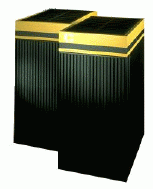
Only 50 MFLOPS, but it's a vector machine so it's actually better than that. Unfortunately it had trouble coming back up after the usual array of power-outages at school: no, this machine was not hooked up to a UPS, we couldn't afford it! This computer has since been trashed to make lab space for a professor to move into. There are two different power supplies for the cabinets, and for the cost of buying two different UPS' that could handle the load, we could buy an entirely new computer. This baby, nevertheless, is mine all mine--I run this 3 x 6 x 5 foot machine at school. The picture on the right shows the two 3 x 3 x 5 towers that this machine is made up of. One of the towers has a cartridge tape, a hard disk, and one or two (the C-220 upgrade) processors. The second has a reel-to-reel tape and four Segate disk drives, along with 16 RS-232 serial ports and a modem. Also, I had 138 reel-to-reels hanging on a rack next to the machine. Of course, 123 of them are blank... It's amazing that this much space was once needed--not that long ago--to make a 100 MFLOPS vector parallel computer. The scalar performance sucks, it's about half that of the HP 9000/720, even tough we had the Scalar Accelerator Hardware (C-32xx CPU). However, vectorized programs are unbelievable: they run faster on this Convex than on the Indigo2 that I rave about below! We overloaded the machine's 128MB of RAM though, by running two moderately-sized program and one big program at one time. This machine was in the same room with the microVAX II that I also talk about below. It's amazing to look at both of them sitting next to each other, and think about the size and processing power differences of the two. Convex was bought by HP, which sold their SPP and C-4 series machines for a while.
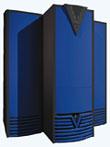

A 17 MFLOPS machine. This was the main software development machine for my dissertation before I started to work for SGI. We ran GAMESS on this machine 24 hours a day, and I added lots of programs from the gnu project to it, such as gcc, g77, gnuplot, gas, and gdb. The picture on the right isn't really a 9000/720, it's a 9000/712, but they're pretty similar looking. The 720 is tan, kind of like the Apple //e, and we don't have the optional floppy disk installed. The hard disks, CD ROM and DDS tape are in a separate box, which is about half the size of the computer itself. With only 40MB of RAM, this machine was limited to two jobs at once. The machine died (I think it's the power supply) and so we used a 9000/735 instead. They are the same thing, just with a 66 MHz CPU in the 735 vs. 50 MHz in the 720. I spent two days installing openssh, binutils, gcc and over 90 patches on the 735...and there's still more I needed to do!

This computer was opened up for use on Sun Jul 28 1996. It was set up to replace the DECSystem 5500 listed below, i.e. this is a machine meant for reading email and writing term papers for college. This "computer" is just one processor on a multi-rack machine, the other processor was for faculty use only. Each processor is about twice as fast as the Convex (running a vectorized program that I used a lot), and each is the equivalent of a RS6000/590 stand-alone. You have no idea what I had to go through to get this picture of the machine. The obvious location, www.cs.cmu.edu/~scandal/gifs.html had a semi-dead link that lead me to IBM in Austin. After searching without success for some time in an attempt to find a picture, I finally went to "RS/6000 Peripherals" and noticed that the picture of their "6094 Spaceball Model 030" (whatever that is) was called lib/graphics/HW/gxt1000.jpg. I made the immediate guess: replace gxt1000.jpg with sp2.gif or sp2.jpg. It worked! Of course, this address has changed since then. Now I can't find the good picture presented to you here on the right anymore, I can only find some way-too-dark picture of a cabinet with no visible detail. Good grief. No wonder I like the Apple //e and don't like the IBM PC. Also, the processors that are on this machine (Model 79) are just a hair slower than a R5000 180MHz Indy. I think that IBM puts this machine on a pedestal just to make it look a lot more impressive than it really is. The interconnect is slow--I've heard the original ones were just 100Base-T, and it takes forever to upgrade the systems to the newer interconnect. Of course now they have the Power4 CPUs, and a killer professional services arm, so there things are holding their own in the marketplace.

This is a coprocessor card for x86 computers. It is a Motorola 68020 25 MHz with a 68882 math co-processor (the same thing the Apple Machintosh II had), and 4 MB of RAM. It can be upgraded to 16MB, and the paged memory management unit (PMMU) can be added to it as well. I ran an old Quantum Chemistry Program Exchange (QCPE) program on it, CNDO. This program has been modified extensively, and can now compute the MCD of a system of up to 1500 atoms or 3000 molecular orbitals, whichever comes first. I've clocked this card at a blazing 0.113 MFLOPS, about the same as a DEC VAX 11/750. The problem with this card is that the integer performance stinks! The floating point performance is great, no doubt due to the 68882, so when running programs on this card, it's best to stick with floating point math and avoid any operations requiring matrices.

This is an IBM compatible computer. It had either 512 or 640K in it, I don't remember, and it really doesn't matter because this machine was the host for the YARC DSI-780+/4 coprocessor. Aside from that, I also ran WordPerfect 5.1 and kermit on this machine, which sat on my desk. It wasn't as fast as the 486/100MHz sitting across from it, and it doesn't have a SuperVGA monitor, but I liked it. The computer has everything I need: WordPerfect 5.1, and a kermit connection straight into the Convex. What more could one person ask for?

I know nothing about this machine, it was sitting on the floor for two years before it was dumped. Features include Digital's monster tape drive (the DLT), a hard disk, and an ethernet port built-in. Most people were asking <= $300 for one of these machines at the time. From the old version of the GAMESS documentation, it seems that this machine is a little slower than a 486/66.
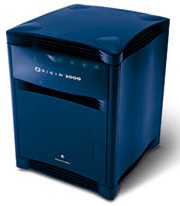
Thank goodness. My university finally purchased some real computer power, a 4x180MHz O2000. There's a quick gigaflop+. Of course, the load average was already above 10 after people had been using it only for a week. Great. It's strange setting up a machine at school as an employee of the company that made it, then using the computer as a student of the university that owns it. Later this machine was upgraded to 6x250MHz, then 8x250MHz, and now it's back down to 4x250MHz. The other CPUs went into upgrading another Origin 2000 system to 16 CPUs. Hey, that other box has FC RAID on it, so you might as well crank that one up and let the one without nearly as much storage space linger for a while. I'm just hoping a few million falls out of the air and we can upgrade this system to 256 processors, or, for that matter, an Origin 3000 with 1024 CPUs, 1 TB of RAM, and a few dozen TB of disk space. Like that will ever happen.
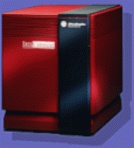
This machine has a single 150MHz R4400, so it's essentially the same as the Challenge XL and Indigo R4K in computational power if your program can only run on one processor at a time. We had a RM4 board in this Crimson however, so can we can do real graphics. I have no idea what those graphics may be, but whatever they are we can do them! This machine started out as a IRIS Power Series 4D/440VGX with four 40MHz R3300 processors. Sad, but it could of been worse: it could of been a 310, which has only one 33MHz processor. SGI sold some of the Crimsons as a "Jurassic Classic" with Steven Speilberg's signature on them, as these machines did the graphics for Jurassic Park. NASA still had at least one of these in the early 21st century.
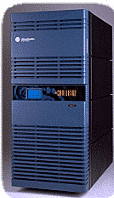
This machine only had four R4400 150MHz processors--LAME! If somebody somewhere would of received a grant then it would of been upgraded to R10000s. This machine was shared between the geeks in the Departments of Physics and Chemistry; all together we ran the machine at load average of 11 on slow days to 14 on "the conference is next week?" days. We used the molecular modeling and electronic structure programs GAMESS and Gaussian 94 and Sybyl on this machine. Since we upgraded to IRIX 6.2 (and later 6.5.x), Sybyl is dead too, because the old version only worked up to IRIX 5.3. This machine, the first SGI and supercomputer I ever worked on, was turned off in 2001 or so and sold for surplus.
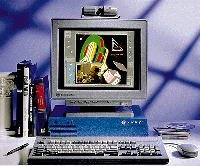
This used to be the machine that I used at work. It had the 180MHz R5000 CPU--Indys also can use the R4600 and R4400 CPUs, and you can tell the R5000 machines by a little silver shark fin next to Indy name that says "R5000" in black. The R4600 CPUs are only good for use as smart terminals really, but the 250MHz R4400 and 180MHz R5000 CPUs can hold their own. This machine is also available, without the graphics card, as the Challenge S, an entry-level server. These machines have been replaced by the O2 line of computers. Indys are still available and will be for some time I suppose.
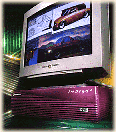
231 MFLOPS of summertime loving, and I only had to share it with one other person! The 24 bit graphics weren't too shabby either... This computer was taken back by SGI when they curtailed their student representative program, so the constant running of GAMESS on this machine is now but a memory. Oh well, it was fun while it lasted! "Power" means this machine had the R8000 CPU in it (as compared to the R4400, and later, the R10000), and "Extreme" was the type of graphics: Elan, Extreme, Maximum Impact, etc.

Faster than the HP 9000/720 by about 1.1 times, if no one else is logged on. However, this computer was used by billions of other students to do word processing, USENET news reading, and email, so that's all I used it for myself. I would include a picture of it here, but the DEC homepage is just a bunch of postscript files...LAME. This machine was taken down forever at Fri Jul 26 12:00:00 EDT 1996 and replaced by the IBM RS/6000 SP2 mentioned above.

This is the machine that the DECSystem 5500 replaced. The university had three of these Pyramids, one each in the English Department, Math Department and in the library. This was the first UNIX box that I ever used. I picked up a student account that lasted one semester as part of English 101, and then transferred my files over to a regular student account on another Pyramid after that class ended, so I had the same account on four different machines: the Pyramid in the English Department, the Pyramid in the library, the DECSystem 5500, and the IBM SP2. Things I put in my .login back in 1987 on the English Pyramid were still in my .login on the SP2 in the late 1990s! By the time the Pyramids were replaced, they were seriously overloaded--and the DECSystem replacements weren't much of an improvement. It's amazing they kept either of those machines as long as we did.

Try not to laugh too hard: this machine runs at about 0.12 MFLOPS. We used it as a serial port splitter, but have since turned it off, because the sole user of Sybyl on this machine stopped using it. A 10Base-T hub with 12 ports took over the role of the microVAX's serial ports, leading to this machine's demise.

I picked this machine up from Neurosurgery Computing over on the medical campus. They had some analog to digital converters installed, and we were going to use the computer to monitor various optical equipment in my thesis advisor's lab. This particular PDP had two 10MB hard disks (the removable kind) and a VT100 terminal as the console. I don't remember how much RAM it had or what other cards were in it because we didn't keep it long. When moving some things around, one of the undergrads hit the disk drive with the boot disk in it... Also, we picked up a WIN 486/33 a short time later (this was 1990ish) and that sealed the fate of this particular PDP.

I learned FORTRAN IV on this machine, under WYLBUR. All I remember, aside from the FORTRAN of course, is FORTIVCLG, part of the JCL that told the machine I wanted to run FORTRAN. Apparently, this machine has since been upgraded to a 3084Q. I haven't used this machine since 1988, so I'm not really in-the-know when it comes to information about this machine. Somebody out there was charging $175/hr of processor time for the use of one of these. Get a load!
The first computer I used was a black-cased Bell & Howell Apple ][ that had been upgraded to an Apple ][+, but without the one-wire shift key mod. It had 48K, 16 color high resolution (280x192) graphics, and was upper-case only. It was great. This was in high school, of course. I typed part of my M.S. thesis in on a Mac IISE, and aside from installing programs on a Mac Plus once, that's my entire Mac experience. At home I have a Franklin Ace 1000 Plus, an Apple ][+ and //e compatible. It's not working...
Lots of IBM compatible computers, and real-live IBMs themselves: PC, XT and AT computers only though, none of the more recent machines. IBM compatibles include WIN, HP touchscreen, AST and Compaq, 286's and up.
Fri Jan 5 16:27:45 EST 2007